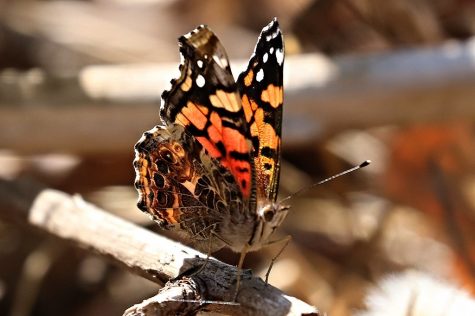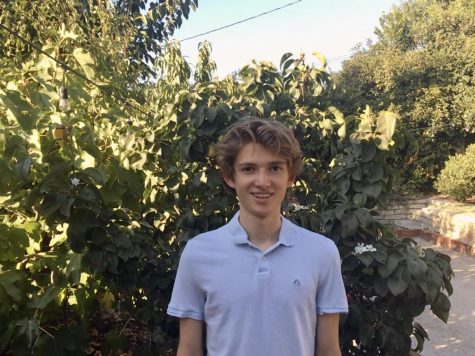Marvelous painted lady butterflies pay Claremont a visit on their journey northward
In recent weeks, nature enthusiasts, aloof athletes, and casual bystanders alike have been transfixed by the multitudes of painted lady butterflies fluttering past them during their daily routines. The break in monotony provided by the butterflies has sparked much curiosity around campus as to why they are migrating through Claremont in such large numbers and where they came from.
In her article, “In the middle of a butterfly crisis, California sees a burst of painted lady,” Deborah Netburn, a reporter for The New York Times, answers all of the questions Claremont residents may have about the painted lady butterflies, and more. According to the article, the butterflies mate in the Mojave and Colorado deserts, feeding on plants, and migrate north through Washington and Oregon (some may go as far north as Alaska). In this way, more rain brings more plant-life, creating a boom in butterfly breeding. With so many plants to feed on, the butterflies are able to fuel themselves for their journey north. The fat stores they build up are stored in a “yellow abdominal packet,” in the words of Netburn. This packet allows butterflies to fly nonstop for as long as possible at speeds of up to 25 mph. When their fat runs out, the painted ladies settle down and rest after long days of migration. In addition to the fat packets, the article lists other beneficial traits of the butterflies: painted ladies can shiver, keeping them warmer in the cold; they also have a wider range of plants that they can eat, giving them a better chance of survival during droughts.
The article cites the aforementioned adaptations as contributors to the fact that painted lady butterflies are a “‘boom-bust’” species. Deborah Dornisch, an attendant at the Butterfly Pavillion in the Rancho Santa Ana Botanic Gardens (RSABG), explains, “A “boom-bust” species is when a species’ population grows exponentially in a short amount of time, then just as rapidly returns to a minimal level. Butterflies and many other insects are great examples of this.”
However, not all butterfly species have the ability to be as successful as the painted lady butterflies are. In fact, Netburn explains that many species of butterflies are reaching all-time lows in population size. No researcher is able to pinpoint the exact cause of this decline, but there are hypotheses about what factors do contribute to the drop in butterfly population. For instance, the loss of “open spaces” because of development, the decline in the numbers of “butterfly-friendly” crops, the increase in the use of pesticides by the agricultural industry, and the increase of temperatures around the globe all have a hand in the butterfly crisis. The recent El Niño weather allowed the painted lady butterflies to boom, making their northern migration much more noticeable for civilians. Specialists continually study the butterfly migration each year, but there are a few years when the butterflies draw the attention of the mass media and are manifest in the lives of civilians.
In a correspondence with the Wolfpacket, Tom Merriman, a butterfly researcher at Butterfly Farms (a nonprofit organization dedicated to the study and preservation of butterflies), clarifies many points on the subject of the painted lady butterflies’ migration. Although the difference between the painted ladies’ population size and other species’ population size is negligible when there is not much rainfall and the painted ladies are unable to boom, Merriman writes, the adeptness of the butterflies becomes apparent when there is more rain.
“The painted lady may be the most successful butterfly in the world. They inhabit deserts and have been found as far north as the Arctic Circle,” Merriman wrote. “The reason for that is the larvae host on a multitude of different plants. This gives them an edge over other butterfly species.”
Merriman wrote that there are as many as 1,000,000,000 (yes, one billion) butterflies migrating north through the western states. However, because of predation, automobiles, pesticides, and loss of habitat, he thinks less than half will complete the journey. So, CHS students and their fellow Claremont citizens should be respectful of these fragile yet resilient creatures.

After the butterflies reach their stopping point up north, they stay for some time, returning south in the fall. However, without their marvelous fat pouches, they are unable to fly for so long without stopping. As a result, they mosey down south, stopping to rest and refuel often along the way. In the fall of this year after school starts, the butterflies could stop to rest in Claremont, and residents and students will have a chance to admire their adeptness in the wild for a second time this year.
Hello there! Our goal is to provide relavent, engaging journalism for readers of all ages. Your donation will support the student journalists of the Wolfpacket at Claremont High School, and will allow us to purchase equipment, print our monthly issues, and enter in journalism competitions. We appreciate your consideration!

A senior in his third year on the Wolfpacket staff, Rowan Orlijan-Rhyne, occasionally referred to as Rowan “Orange Rind” by his Wolfpacket peers, strives...




